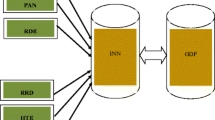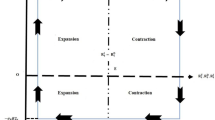Abstract
This study empirically investigates the causal relationship between research and development (R&D) expenditure and innovation in Greece, during the period 1981–2009. It uses time series analysis, the theoretical background of the endogenous knowledge-based growth theories and the annual number of patent applications to the European Patent Organization as proxy of innovation activity. The Johansen method is applied to examine the possibility of co-integration. The results confirm the presence of a long-run relationship between R&D expenditure and innovation. The total and private R&D expenditure appear to have a positive effect on total and business innovation. In addition, the public R&D expenditure has a positive influence on business and total innovation, which indicates the existence of significant externalities of public sector research. The long-run elasticity of innovation with respect to R&D expenditure is estimated to be, on average, 1.9. Implications for public policies and related practices are formulated.


Similar content being viewed by others
Notes
Ministry of Development, General Secretariat for Research and Technology, Research & Development in Greece.
For the years before 1990, missing points have been completed on the basis of the data provided in the appendix of the paper of Coe and Helpman (1995) for the R&D expenditure in Greece (1995). As they presented information only for the business R&D, it was assumed that the total R&D expenditure followed a similar trend with that of the business sector in order to complete the missing values. For the period after 1990, the missing points were completed with linear interpolation.
The stationarity of the time series is tested with the Augmented Dickey–Fuller (ADF), Dickey–Fuller GLS (DF-GLS) (Dickey and Fuller 1979) and Phillips–Perron (Phillips and Perron 1988) tests. The tests are carried out in the level and in the first difference for each variable. Cointegration tests are based on the methodology developed by Johansen (1991, 1995). Two alternative tests are used, namely the Trace test and the Maximum Eigenvalue test. The selected cointegration model has linear trend in the data, but no trend in the cointegrating equation. The selection of the appropriate number of lags is based on the minimization of the Schwarz and Akaike information criteria. Error correction models are used for the examination of the short-term relationship of cointegrated variables. Granger-causality tests (Granger 1969, 1988) are performed on the basis of the error correction models.
References
Aghion, P., & Howitt, P. (1992). A model of growth through creative destruction. Econometrica, 60, 323–351.
Azagra-Caro, J. M., & Consoli, D. (2014). Knowledge flows, the influence of national R&D structure and the moderating role of public–private cooperation. The Journal of Technology Transfer, 39(6), 1–21.
Belluci, A., & Pennacchio, L. (2015). University knowledge and firm innovation: evidence from European countries. The Journal of Technology Transfer, 40(2), 1–23.
Bilbao-Osorio, B., & Rodriguez-Pose, A. (2004). From R&D to innovation and economic growth in the EU. Growth and Change, 35(4), 434–455.
Bottazzi, L., & Peri, G. (2007). The international dynamics of R&D and innovation in the long run and in the short run. Economic Journal, 117(518), 486–511.
Carayannis, E., & Campbell, D. (2009). ‘Mode 3’ and ‘Quadruple Helix’: Toward a 21st century fractal innovation ecosystem. International Journal of Technology Management, 46(3–4), 201–234.
Carayannis, E., & Grigoroudis, E. (2014). Linking innovation, productivity, and competitiveness: Implications for policy and practice. The Journal of Technology Transfer, 39(2), 199–218.
Carayannis, E., & Rakhmatullin, R. (2014). The quadruple/quintuple innovation helixes and smart specialization strategies for sustainable and inclusive growth in Europe and beyond. The Journal of the Knowledge Economy, 5(2), 212–239.
Coe, D. T., & Helpman, E. (1995). International R&D spillovers. European Economic Review, 39, 859–887.
Coe, D. T., Helpman, E., & Hoffmaister, A. (2009). International R&D spillovers and institutions. European Economic Review, 53, 723–741.
Conte, A. (2014). Efficiency of R&D spending at national and regional level. Joint Research Centre, European Commission (in press).
de Rassenfosse, G., & van Pottelsberghe de la Potterie, B. (2012). On the price elasticity of demand for patents. Oxford Bulletin of Economics and Statistics, 74(1), 58–77.
Dennis, J. E., & Schnabel, R. B. (1983). Numerical methods for unconstrained optimization and nonlinear equations. London: Prentice-Hall.
Dickey, D., & Fuller, W. (1979). Distribution of the estimators for autoregressive time series with a unit root. Journal of the American Statistical Association, 74, 427–431.
Etzkowitz, H., & Leydesdorff, L. (1995). The triple Helix-University–Industry–Government relations: A laboratory for knowledge based economic development. EASST Review, 14, 14–19.
European Commission. (2014). EU Cohesion Policy 2014–2020. http://ec.europa.eu/regional_policy/index.cfm/en/information/publications/presentations/2014/investing-in-regions-the-reformed-eu-cohesion-policy-2014-2020. Accessed February 2015.
Eurostat statistical database (data for intramural R&D expenditure, patent applications to the EPO). http://ec.europa.eu/eurostat/data/database. Accessed July 2014.
Granger, C. W. J. (1969). Investigating causal relations by econometric models and cross-spectral methods. Econometrica, 37(3), 424–438.
Granger, C. W. J. (1988). Some recent developments in a concept of causality. Journal of Econometrics, 38, 199–211.
Grossman, G. M., & Helpman, E. (1991). Innovation and growth in the world economy. Cambridge, MA: MIT Press.
Guerrero, M., Cunningham, D., & Urbano, J. A. (2015). Economic impact of entrepreneurial universities’ activities: An exploratory study of the United Kingdom. Research Policy, 44(3), 748–764.
Jaffe, A. (1986). Technological opportunity and spillovers of R&D: Evidence from firms’ patents, profits and market value. The American Economic Review, 76(5), 984–1001.
Johansen, S. (1991). Estimation and hypothesis testing of cointegration vectors in gaussian vector autoregressive models. Econometrica, 59, 1551–1580.
Johansen, S. (1995). Likelihood-based inference in cointegrated vector autoregressive models. Oxford: Oxford University Press.
Jones, C. I. (1995). R&D-based models of economic growth. Journal of Political Economy, 103, 759–784.
Klette, T. J., Moen, J., & Griliches, Z. (2000). Do subsidies to commercial R&D reduce market failures? Microeconometric evaluation studies. Research Policy, 29(4), 471–495.
Martin, S., & Scott, J. T. (2000). The nature of innovation market failure and the design of public support for private innovation. Research Policy, 29(4–5), 437–447.
Pegkas, P., & Tsamadias, C. (2014). Does higher education affect economic growth? The case of Greece. International Economic Journal, 28(3), 425–444.
Phillips, P. C. B., & Perron, P. (1988). Testing for a unit root in time series regression. Biometrika, 75, 335–346.
Porter, M., & Stern, S. (2000). Measuring the “Ideas” production function: evidence from international patent output. NBER Working Paper 7891.
Romer, P. (1990). Endogenous technological change. Journal of Political Economy, 98, 71–102.
Teixeira, A. C., & Fortuna, N. (2010). Human capital, R&D, trade, and long-run productivity. Testing the technological absorption hypothesis for the Portuguese economy, 1960–2001. Research Policy, 39(3), 335–350.
Voutsinas, I., & Tsamadias, C. (2014). Does Research and Development capital affect total factor productivity? Evidence from Greece. Economics of Innovation and New Technology, 23(7), 631–651.
Author information
Authors and Affiliations
Corresponding author
Rights and permissions
About this article
Cite this article
Voutsinas, I., Tsamadias, C., Carayannis, E. et al. Does research and development expenditure impact innovation? theory, policy and practice insights from the Greek experience. J Technol Transf 43, 159–171 (2018). https://doi.org/10.1007/s10961-015-9454-3
Published:
Issue Date:
DOI: https://doi.org/10.1007/s10961-015-9454-3




